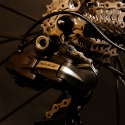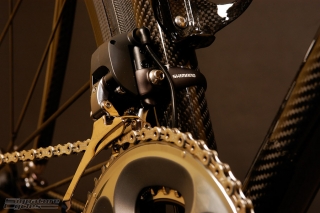 In many ways, we cyclists are trying to get back to the simplicity of when we first fell in love with cycling. The simplicity of that first single speed bike on which we learned to ride. All you had to think about was turning the cranks over and pointing the wheel wherever you wanted to go. The desire to get that feeling back is evident in the resurgence of the single speed bike in urban areas around the world. However, as our cycling aspirations increased, so did the need for a broader range of gearing. We had to learn a host of new skills, how to shift, when to shift, the most efficient cadence. We traded the simplicity for speed, comfort, and distance.
In many ways, we cyclists are trying to get back to the simplicity of when we first fell in love with cycling. The simplicity of that first single speed bike on which we learned to ride. All you had to think about was turning the cranks over and pointing the wheel wherever you wanted to go. The desire to get that feeling back is evident in the resurgence of the single speed bike in urban areas around the world. However, as our cycling aspirations increased, so did the need for a broader range of gearing. We had to learn a host of new skills, how to shift, when to shift, the most efficient cadence. We traded the simplicity for speed, comfort, and distance.
When we think about Shimano’s new electronic shifting systems (I use the plural with the release of Ultegra Di2 rapidly approaching), simple is not the first adjective that comes to mind. These are complex systems built of servo motors and wires. But, when we ride with electronic shifting, it feels simple. Press the shift button and the chain is already there, in the gear you’ve selected, before you have time to think about altering you pedal stroke. Di2 allows us to forget again. To forget about all those gears and think only of turning the cranks. Pointing the wheel wherever we want to go.
When Shimano first introduced Dura-Ace Di2 it threw a pump in the spokes of bike designers who had spent decades creating bikes designed to run shift cables. What would they do with all the wires? Shimano provides a nice tape kit to route the wires down the downtube and under to bottom bracket, but clearly that wouldn’t be the final aesthetic solution. Just like cables on time trial bikes, the wires had to go inside the frame. The problem for the major bicycle manufacturers is that they are is the business of creating One Bike to Rule Them All. Their top of the line model have to be everything to everybody. And when a production run is ordered from the factory, months before it is released to the public, it has to work with both traditional cable shifting and this new electronic wild card, lest they lose any potential customers. From this challenge came a lot of odd designs attempting to use the same routing for both systems, or provide removable routing to the system you weren’t using. Some designs were obviously more successful than others.
Much more able to adapt to the new system, are the custom builders. A custom bicycle is, of course, one built to your exact specifications. Whichever shifting system you choose, the craftsmen creating your frame will design it to work perfectly with that system. If you decide to go with electronic shifting, the wiring will be seamlessly integrated into the frame. The battery can also be placed in an optimum position to keep it out of harms way and to keep the center of gravity low. Most builders have chosen to place the Di2 battery at the bottom of the downtube or on the non-drive chainstay. Often they fabricate custom mounts to more cleanly and securely hold the battery. The beauty comes from making a complex system appear as simple as it feels when you use it.
Here at Signature Cycles we carry many of the biggest custom bicycle brands in North America. Brands who have been leading the charge designing bikes specifically for electronic shifting. We are the #1 dealer of Shimano Dura-Ace Di2 systems in North America, and the sales are only increasing as more people get the opportunity to experience the group. We are excited for the upcoming release of the Ultegra level Di2 components, as it will make electronic shifting available to a much broader range of riders. We believe in the ability of these electronic systems to change the way we ride our bikes, and we hope you will take the opportunity to come by our studios and try them out for yourself. Then we can help you and your frame builder design your perfect bike to go with it, and you can point those wheels wherever you want to go.

